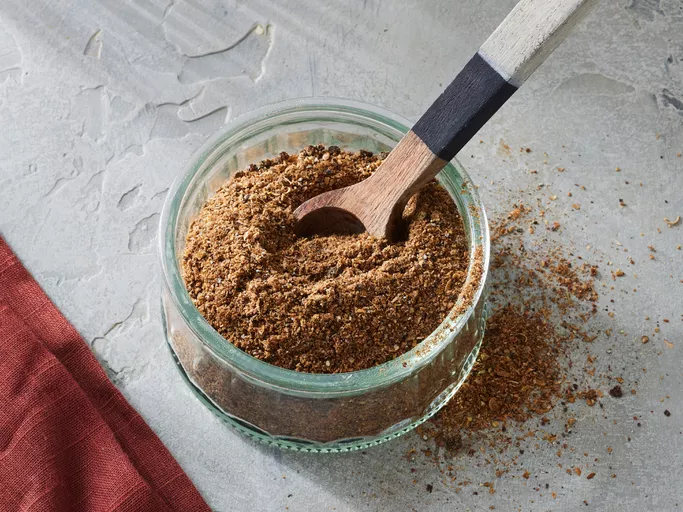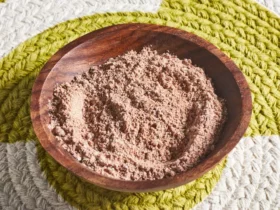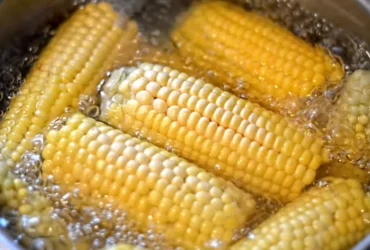Ingredients and Preparation
Main Ingredients
Garam masala is a blend of ground spices that originated in India and has since become a staple spice mixture in many Indian and Middle Eastern dishes. The key to making a good garam masala is to use high-quality ingredients, including whole spices that can be toasted and then ground into a fine powder.
The main ingredients in garam masala include cloves, cardamom pods, cinnamon sticks, cumin seeds, coriander seeds, fennel seeds, mace, black peppercorns, and nutmeg. You will need 2 tablespoons of each of the following spices: ground ginger, ground cinnamon, ground cardamom, ground cumin, ground coriander, ground cayenne pepper, and salt.
You will also need 1 tablespoon of grated nutmeg, 1 tablespoon of grated mace, and 2 tablespoons of black peppercorns. You can adjust the proportions of each spice to taste, but this is a good starting point.
It’s worth noting that garam masala is one of those spices where freshness is key. If you’re buying pre-ground garam masala at the store, it may have lost its potency and flavor over time. So it’s best to make your own from whole spices.
To start making garam masala, toast each spice separately in a small skillet or saucepan over low heat, stirring constantly, until fragrant. This is an important step as it releases the oils and flavors of the spices.
Once all the spices are toasted, let them cool completely before grinding them into a fine powder using a spice grinder or a coffee grinder. You can also use a rolling pin to grind the spices in a mortar and pestle.
Store your homemade garam masala in an airtight container for up to 6 months. This makes about 1/4 cup of garam masala, which you can use in place of store-bought garam masala in most recipes.
This is a simple and easy recipe that allows you to customize the flavor to your liking. You can adjust the proportions of each spice based on your personal taste preferences and experiment with different combinations to create unique flavor profiles.
2 tablespoons coriander seeds
When making the easy garam masala recipe, it’s essential to start by preparing the ingredients. For this particular step, you’ll need 2 tablespoons of coriander seeds.
Coriander seeds are a fundamental component in many Indian and Middle Eastern spice blends, including garam masala. They have a warm, earthy flavor that complements the other spices in the blend perfectly.
To prepare the coriander seeds for use in your garam masala recipe, start by toasting them lightly over low heat in a dry pan. This will help to bring out their natural oils and intensify their flavor.
Once the coriander seeds are fragrant and lightly toasted, allow them to cool completely before using them in your garam masala blend. You can store any leftover coriander seeds in an airtight container for future use.
When blending the spices together to make the garam masala, be sure to include the toasted coriander seeds as one of the key ingredients. This will ensure that your finished spice blend has the rich, aromatic flavor you’re looking for.
1 tablespoon cumin seeds
Cumin seeds are a crucial ingredient in many Indian recipes, including garam masala blends. They are small, yellowish-brown seeds with a distinct earthy and slightly bitter flavor. To use cumin seeds in your easy garam masala recipe, you will need to grind them into a fine powder.
To do this, simply place the desired amount of cumin seeds (in this case, 1 tablespoon) in a spice grinder or coffee grinder. Grind the seeds for about 10-15 seconds, or until they are finely ground and powdery. Be careful not to over-grind the seeds, as this can lead to a bitter flavor.
Once you have your cumin powder, you can add it to your garam masala blend along with other ingredients like cloves, cardamom, cinnamon, black pepper, and nutmeg. The ratio of each spice will depend on personal preference, but a common starting point is 2-3 tablespoons of cumin powder for every teaspoon of garam masala.
It’s worth noting that whole cumin seeds can be used as an aromatic ingredient in recipes, particularly those with slow-cooked sauces or curries. Simply add the seeds towards the beginning of cooking time and allow them to infuse into the dish. This is a great way to add depth and warmth to your dishes without having to grind the seeds beforehand.
Overall, cumin seeds are a versatile and essential ingredient in many Indian recipes, including garam masala blends. By grinding them into a fine powder or using whole seeds as an aromatic ingredient, you can add rich and complex flavors to your cooking.
1 teaspoon cinnamon stick
To make the Easy Garam Masala Recipe, you will need a combination of aromatic spices that are commonly used in Indian cuisine. One key ingredient is cinnamon, which adds warmth and depth to the dish.
In this recipe, we use 1 teaspoon of cinnamon stick, also known as Ceylon cinnamon or true cinnamon. This type of cinnamon comes from the bark of the Cinnamomum verum tree and has a distinctive, sweet flavor with a hint of earthy undertones.
To prepare the cinnamon for use in the recipe, you will need to grind it into a fine powder using a spice grinder or mortar and pestle. This is because ground cinnamon is more easily absorbed by the other spices and contributes to the overall flavor profile of the garam masala.
Alternatively, if you do not have access to a spice grinder or mortar and pestle, you can use pre-ground cinnamon powder as a substitute in this recipe. However, keep in mind that freshly ground spices tend to be more flavorful and aromatic than pre-ground ones.
Once you have ground the cinnamon into a fine powder, you can mix it with the other ingredients according to the Easy Garam Masala Recipe instructions. The cinnamon will blend seamlessly with the other spices, such as cardamom, cloves, and black pepper, to create a fragrant and savory spice blend that is perfect for adding depth and warmth to various Indian dishes.
68 green cardamom pods
To make this Easy Garam Masala Recipe, you will need to start by gathering the necessary ingredients, which include 68 green cardamom pods.
The first step in preparing these green cardamom pods for use in your recipe is to remove their outer husks and extract the seeds. This can be done by carefully pinching or cutting off the top of each pod and then gently pulling out the seeds from within. It’s essential to be gentle when removing the seeds to avoid crushing them, as this can affect the flavor and aroma of your finished Garam Masala.
Once you have extracted the seeds from all 68 green cardamom pods, place them in a small bowl or tray. You may need to use your fingers or a small utensil to separate any remaining seeds or pulp that has accumulated during the process.
Next, dry the extracted green cardamom seeds in a single layer on a baking sheet lined with parchment paper. This will help to prevent them from clumping together and make it easier to store them later on.
Allow the green cardamom seeds to air-dry for several hours or overnight before grinding them into a fine powder using a spice grinder, coffee grinder, or mortar and pestle. Be sure to grind in small batches to prevent clogging your device or creating a messy mixture.
Continue grinding until you have achieved the desired consistency for your Garam Masala blend. Some people prefer a finer powder, while others like it slightly coarser. It’s essential to remember that the texture and flavor of your finished Garam Masala will depend on how finely you grind the green cardamom seeds.
After grinding all 68 green cardamom pods into a fine powder, transfer them to an airtight container for storage. This is where you can keep your homemade Garam Masala blend fresh and flavorful for up to six months or longer if stored properly in the refrigerator or freezer.
1/2 teaspoon ground black pepper
The key to making an authentic Indian spice blend like garam masala lies not only in the quality and combination of ingredients but also in their proper preparation.
Garam masala, a staple seasoning in many Indian cuisines, is known for its aromatic and slightly bitter flavor profile. This complex spice blend typically includes ground spices such as cloves, cardamom, cumin, cinnamon, coriander, black pepper, and sometimes nutmeg or star anise.
One of the critical components of garam masala is black pepper, which contributes a sharp, slightly bitter taste and a pungent aroma to the blend. Using high-quality black peppercorns is essential for achieving the desired flavor in your homemade garam masala mix.
To prepare this key ingredient for your spice blend, start by grinding 1/2 teaspoon of fresh black peppercorns into a fine powder using a coffee grinder or a dedicated spice grinder. The goal is to achieve an even texture and release the full potency of the spices. If you’re short on time or prefer a more convenient approach, store-bought pre-ground black pepper will also suffice.
Remember that the ratio of each ingredient in garam masala can vary depending on personal preference or specific regional traditions. However, using 1/2 teaspoon of ground black pepper as part of your overall spice blend is a good starting point for creating an authentic and balanced flavor profile.
Once you’ve prepared your ingredients, combine the ground black pepper with other essential components like cloves, cardamom, cumin, cinnamon, and coriander to create your homemade garam masala mix. Experiment with different proportions of each ingredient to find the perfect blend that suits your taste buds.
2 cloves
To make easy garam masala at home, you will need the following ingredients:
- Ginger: 1-inch piece of fresh ginger root, peeled and sliced thinly
Cloves:
- 2 whole cloves, or more to taste
- Cinnamon Stick: 1 small stick of Ceylon cinnamon (or regular cinnamon), broken into pieces
- Cardamom Pods: 6-8 green cardamom pods, crushed lightly with a mortar and pestle
- Black Peppercorns: 2-3 whole black peppercorns
Cloves (ground):
- 2 teaspoons of ground cloves, or more to taste
To prepare the garam masala blend:
- In a small pan, heat 1 tablespoon of oil over low heat.
- Add the sliced ginger and cook for about 2-3 minutes or until it’s soft and lightly browned, stirring occasionally.
- Add the whole spices (cinnamon stick pieces, cardamom pods, black peppercorns, and whole cloves) to the pan and stir to combine with the ginger. Cook for another minute, being careful not to let them burn.
- Remove the pan from the heat and let it cool slightly.
- Using a spice grinder or mortar and pestle, grind the spices into a fine powder. You may need to do this in batches depending on your equipment. Be careful not to over-grind as it can become bitter.
- Mix the ground ginger with the ground spices and adjust the seasoning if necessary.
Store your homemade garam masala blend in an airtight container at room temperature for up to 6 months. You can use it to add flavor to various dishes, such as curries, soups, stews, and roasted vegetables.
Preparing the Spices
The preparation of garam masala is an essential part of Indian cuisine, which typically involves a combination of spices that are toasted and ground together. This process brings out the full flavor potential of each ingredient and creates a harmonious balance.
To begin with, you’ll need to prepare your individual spices before grinding them into powder. Each spice has its own unique characteristics and contributes its distinct flavor and aroma when combined.
Firstly, take coriander seeds. They are the base of most garam masala blends due to their earthy, nutty taste and crunchy texture. To prepare them, you can simply dry roast a teaspoon of coriander seeds in a pan over low heat or use a toaster oven at 250 degrees Fahrenheit for about five minutes.
Next is cumin seed, which is also an integral part of most garam masala recipes due to its pungent and earthy flavor. Similar to coriander, you can simply dry roast a teaspoon of cumin seeds in the pan or toaster oven for 5-7 minutes until fragrant.
Cinnamon sticks are another fundamental component in many Indian garam masala blends due to their warm, sweet aroma. To prepare the cinnamon stick, cut it into smaller pieces and dry roast them in the pan over low heat or use a toaster oven at 250 degrees Fahrenheit for about five minutes.
Cardamom pods contribute their unique sweet yet pungent flavor to many Indian recipes. Roast two cardamom pods by placing them on the pan with some oil until fragrant, which should take around 5-7 minutes over low heat. Remove and let cool completely before grinding.
Cloves are a standard component in most garam masala blends due to their strong, pungent flavor and warm aroma. Similar to cinnamon sticks, cut the cloves into smaller pieces and dry roast them in the pan or toaster oven for 5 minutes over low heat until fragrant.
Nutmeg seeds add an aromatic sweetness and depth to most Indian garam masala recipes. Roast a nutmeg seed by placing it on the pan with some oil until it’s slightly darkened, which should take around five minutes over low heat. Allow it to cool completely before grinding.
Lastly, take one black pepper corn which adds its distinctive pungent flavor and aroma. Similar to coriander seeds, dry roast a black pepper corn in the pan or toaster oven for 5-7 minutes until fragrant.
Once your spices are toasted, let them cool completely before grinding. You can use either an electric coffee grinder or spice grinder to grind all your prepared spices into powder form. Combine and mix well.
Grind the coriander, cumin, cinnamon, and cardamom in a spice grinder until coarsely ground. You can also dry roast them lightly in a pan for added flavor.
The first step in making garam masala is to prepare the individual spices, which include coriander, cumin, cinnamon, and cardamom. To begin, you’ll need to grind these spices into a coarse powder.
There are two methods you can use to grind the spices: using a spice grinder or dry roasting them in a pan. The choice between the two methods will ultimately depend on your personal preference and the level of flavor intensity you’re aiming for.
First, let’s consider grinding the spices in a spice grinder. This is a quick and easy method that produces a consistent texture throughout the powder. Simply add the coriander, cumin, cinnamon, and cardamom to the grinder, close the lid, and grind until the mixture reaches your desired level of coarseness.
Alternatively, you can dry roast the spices in a pan for added flavor depth. This method is particularly effective if you’re looking to bring out the natural oils and aromatic compounds within the spices. To dry roast the spices, simply heat a small amount of oil or ghee in a pan over medium heat. Once the oil is hot, add the coriander, cumin, cinnamon, and cardamom to the pan, stirring constantly to prevent burning.
Continue roasting the spices for 2-3 minutes, or until they reach your desired level of fragrance and flavor. Be careful not to over-roast the spices, as this can cause them to become bitter and unpalatable.
Once you’ve achieved the desired level of coarseness or roastiness, remove the spices from the grinder or pan and let them cool completely before proceeding with the garam masala recipe. This ensures that the flavors within the spices are evenly distributed throughout the powder, resulting in a more complex and aromatic final product.
Making the Garam Masala
The Roasting Process
The roasting process is a crucial step in making garam masala, as it brings out the deep, rich flavors and aromas of the spices. To begin with, you will need to select high-quality whole spices that are free from added preservatives or artificial flavor enhancers.
Some of the essential spices used in making garam masala include cinnamon sticks, cardamom pods, cumin seeds, coriander seeds, fennel seeds, mace, nutmeg, and black peppercorns. You may also choose to add other spices like cloves or star anise, depending on your personal preference.
Preheat a dry pan or skillet over low-medium heat, and carefully add the whole spices. You can use either a cast-iron or stainless steel pan for this process, as these materials retain heat well and allow for even roasting.
Spread the spices evenly across the bottom of the pan to ensure that they roast uniformly. As the spices begin to release their oils and start emitting a fragrant aroma, you can stir them gently with a spoon or spatula to prevent burning.
The key is to roast the spices slowly and patiently, allowing each one to reach its optimal flavor potential. This process usually takes about 10-15 minutes for most whole spices, but this time may vary depending on their individual roasting times and the heat level of your pan.
Once the spices have reached the desired level of fragrance and color, you can remove them from the heat immediately to prevent over-roasting. If some spices are still raw or under-roasted after 15 minutes, continue to roast them for short intervals until they reach perfection.
To ensure even roasting and minimize the risk of burning, it’s essential to stir the spices frequently during this process. Also, be cautious not to overcrowd the pan, as this can lead to uneven heating and a reduced quality garam masala.
Finally, allow the roasted spices to cool completely before grinding them into a fine powder using a spice grinder or mortar and pestle. This will help preserve the delicate flavors and aromas developed during the roasting process.
Heat 1 tablespoon of oil in a small pan over low heat. Add the coriander, cumin, cinnamon, cardamom, and black pepper mixture to the pan and roast for about 1015 minutes or until fragrant.
- To make Garam Masala, start by heating 1 tablespoon of oil in a small pan over low heat.
- This will help to prevent the spices from burning and ensure that they roast evenly.
- Once the oil is hot, add the coriander seeds, cumin seeds, cinnamon sticks, green cardamom pods, and black peppercorns to the pan.
- The mixture should fill about 1/4 of the pan, so don’t overcrowd it.
- Roast the spice mixture for about 10-15 minutes or until fragrant, stirring occasionally.
- You’ll know that the spices are ready when they release their aroma and start to darken slightly in color.
- Be patient and keep an eye on the pan, as the spices can easily burn if left unattended.
- Once the spices are roasted, remove them from the heat and let them cool completely.
- This will help to prevent the development of bitterness and ensure that the Garam Masala has a balanced flavor.
- Grind or blend the cooled spice mixture into a fine powder using a spice grinder, mortar and pestle, or blender.
- Sift the ground spices through a fine-mesh sieve to remove any lumps and achieve a uniform texture.
- The resulting Garam Masala can be stored in an airtight container for up to 6 months.
Grinding and Sifting
The process of making garam masala involves grinding various whole spices into a fine powder that captures their distinct flavors and aromas. This blend of ground spices plays a crucial role in many Indian recipes, adding warmth, depth, and complexity to dishes.
For the best flavor, it’s essential to grind each spice separately before combining them into a single mix. Some common ingredients used to make garam masala include cloves, cardamom pods, cinnamon sticks, cumin seeds, coriander seeds, and black peppercorns.
The first step in grinding these spices is to dry roast the whole spices until they emit an aroma that indicates they have reached their optimal flavor potential. This can be achieved by heating a pan over medium heat, then carefully adding the whole spices while constantly stirring them with a spatula to prevent burning.
Once the spices are fragrant and slightly darkened, remove them from the pan and let them cool down completely before proceeding with the next step.
Grinding can be achieved using various methods such as mortar and pestle, spice grinder, or coffee grinder. For best results, use a spice grinder to ensure the spices are ground finely without generating excessive heat that could damage their flavors.
After grinding, sift each spice blend through a fine-mesh sieve to separate any lumps, dust, or larger particles from the desired powdered form. This step is crucial in achieving an even texture and avoiding lumps that may appear in the final garam masala powder.
For the sifting process, simply place the ground spice blend into a fine-mesh sieve lined with cheesecloth or a clean cotton cloth. Gently shake the sieve until most of the excess dust is eliminated.
To store garam masala, transfer it to an airtight container like glass jars with tight-fitting lids. Keep the container away from direct sunlight and moisture to preserve its flavor and aroma for an extended period.
Keep in mind that homemade garam masala typically lasts longer than store-bought varieties due to the lack of additives, preservatives, and other chemicals often found in commercial blends. Regular use and a well-maintained storage environment will help ensure the longevity of your freshly made garam masala powder.
For optimal results, consider labeling the container with the date it was prepared and any notable notes about its flavor or aroma profile. This information can be helpful when using different batches or recipes that require specific types of garam masala.
Remember to always handle whole spices gently while cleaning, storing, and grinding them to preserve their delicate flavors and aromas. With patience and attention to detail, you’ll enjoy the rich complexity and depth that homemade garam masala brings to your culinary creations.
Let the spice blend cool completely before grinding it into a fine powder using a spice grinder. Sift the ground Garam Masala through a finemesh sieve to remove any lumps or large particles.
The first step in making homemade Garam Masala involves gathering a variety of aromatic spices and dried ingredients, including cloves, cardamom pods, cinnamon sticks, green cardamom seeds, black peppercorns, mace pieces, and star anise.
Begin by toasting the whole spices over medium heat for about 5 minutes, stirring occasionally to prevent burning. This process is essential in enhancing the flavor and aroma of the spices.
Remove the toasted spices from the heat and let them cool down completely before proceeding with grinding them into a fine powder.
Preparing the Spices
To prepare the individual components for grinding, you will need to crack open the cardamom pods to release the seeds, and break the cinnamon sticks into smaller pieces. The mace can be chopped into smaller fragments using a sharp knife or a mortar and pestle.
Grinding the Spices
Once all the ingredients are prepared, let them cool down completely before grinding them in a spice grinder until they form a fine powder. Be careful not to overheat the grinder, as this can lead to the spices becoming bitter or losing their aroma.
Sifting the Garam Masala
After grinding the spices, sift the resulting mixture through a finemesh sieve to remove any lumps or large particles that may have formed during the grinding process. This step is crucial in ensuring that the Garam Masala powder is smooth and consistent in texture.
Tips for Storing Garam Masala
To maintain the flavor and aroma of your homemade Garam Masala, store it in an airtight container and keep it away from direct sunlight and moisture. You can also add a small amount of oil or vinegar to prevent the spices from becoming stale.
Using Your Homemade Garam Masala
Your homemade Garam Masala is now ready to be used in various Indian dishes, such as curries, stews, and braises. Simply sprinkle it over your food or add it to the cooking pot for an instant boost of flavor and aroma.
Using Your Homemade Garam Masala
Flavor Enhancement
Garam Masala is one of the most essential spices in Indian and Middle Eastern cuisine, often referred to as a spice blend rather than a single spice itself. It plays a crucial role in adding depth and warmth to various dishes, from soups to curries, and is typically used towards the end of cooking to prevent its delicate flavors from dissipating.
While store-bought Garam Masala can be convenient, homemade versions offer a more vibrant and nuanced flavor profile. The key to crafting an exceptional homemade Garam Masala lies in carefully selecting each ingredient and combining them in optimal proportions.
A well-balanced homemade Garam Masala should typically consist of seven fundamental spices: cinnamon, cardamom, cloves, cumin seeds, coriander seeds, black peppercorns, and nutmeg. Each spice contributes its unique aroma and taste to the blend, making it essential to roast them individually before grinding them together.
To begin making your homemade Garam Masala, start by separating the individual spices into different bowls or airtight containers. You will need:
- 1-2 cinnamon sticks (depending on size) broken into smaller pieces
- 2-3 green cardamom pods broken open to release their seeds and inner pod
- 6-8 whole cloves
- 1 tablespoon cumin seeds
- 1 tablespoon coriander seeds
- 12 black peppercorns
- A small pinch of grated fresh nutmeg (about 1/4 teaspoon)
Roast the spices individually in a 300°F oven for about 10 minutes, or until fragrant and slightly darkened. This step is crucial to releasing the volatile oils within each spice, which contribute greatly to its overall flavor.
Allow the roasted spices to cool completely before grinding them into a fine powder using an electric coffee grinder, spice mill, or mortar and pestle. Be cautious when grinding as the aroma of the spices will fill the air, making your kitchen smell heavenly!
Once you’ve ground all the spices together, combine them in a small bowl and mix thoroughly. Store your homemade Garam Masala in an airtight container at room temperature for up to six months.
To use your homemade Garam Masala, add it towards the end of cooking time when making curries or stews, allowing its flavors to infuse into the dish as it simmers. For maximum flavor, start with a small amount (about 1/4 teaspoon) and adjust to taste, remembering that you can always add more but cannot remove excess spices once they’ve been added.
With this homemade Garam Masala recipe, you’ll be able to elevate your cooking and create authentic Indian dishes at home. Experiment with various proportions of the spices to develop your own signature blends, and enjoy the journey of mastering this incredible spice blend!
This homemade Garam Masala adds depth and warmth to a variety of Indian dishes such as curries, stews, and rice pilafs. Use it sparingly for maximum flavor impact.
The aroma of homemade Garam Masala spice blend is a game-changer for any Indian dish, and with this easy recipe, you can create it in the comfort of your own kitchen. This essential spice blend adds depth and warmth to a variety of Indian dishes such as curries, stews, and rice pilafs.
Traditionally, Garam Masala is made with a combination of ground spices, but the beauty of this homemade recipe lies in its simplicity. You’ll need just six ingredients: cinnamon, cardamom, cloves, black pepper, cayenne pepper, and mace. Yes, you read that right – just six ingredients!
Here’s how to make your own homemade Garam Masala: Simply grind the cinnamon, cardamom, cloves, and mace in a coffee grinder or spice grinder until they’re well combined. Be sure to break up any lumps and mix the spices thoroughly.
Add the black pepper and cayenne pepper to the mixture and grind them into the spice blend. The cayenne pepper gives Garam Masala its signature warmth, so adjust the amount according to your desired level of heat. You can always add more cayenne pepper, but it’s harder to remove excess spice.
To store your homemade Garam Masala, place it in an airtight container and keep it away from light and moisture. This will help preserve the fragrance and flavor of the spices. Use it sparingly for maximum flavor impact, as too much Garam Masala can overpower your dish.
This homemade Garam Masala recipe is perfect for those who want to add an authentic Indian touch to their cooking. With its rich aroma and complex flavors, it’s a staple spice blend that every Indian cuisine enthusiast should have in their pantry. So go ahead, give this easy recipe a try, and experience the magic of homemade Garam Masala!
Storage Tips
- To get the most out of your homemade Garam Masala, it’s essential to store it properly.
- One of the biggest advantages of making your own Garam Masala is that you can control the ingredients and their proportions, allowing for a more complex flavor profile than many commercial blends.
- However, this also means that you need to take extra care when storing it to maintain its potency and aroma.
- Here are some tips on how to store your homemade Garam Masala:
- Airtight Container: Transfer the freshly ground Garam Masala to an airtight container, such as a glass jar with a tight-fitting lid.
- This will prevent air from entering the container and causing the spices to lose their flavor and aroma.
- Cool Place: Store the Garam Masala in a cool, dry place away from direct sunlight and heat sources.
- A dark cupboard or pantry is ideal for storing your homemade Garam Masala.
- Minimize Exposure to Moisture: Try to minimize the exposure of your Garam Masala to moisture, as this can cause the spices to become clumpy and lose their flavor.
- Freshness Indicators: To ensure that your Garam Masala remains fresh for a longer period, look out for signs of staleness, such as a loss of aroma or a change in color.
- When you notice these signs, it’s time to make a fresh batch of Garam Masala.
- Use Within 6 Months: Homemade Garam Masala typically lasts for up to 6 months when stored properly.
- After this period, the flavor and aroma may begin to fade, making it less effective as a spice blend.
- By following these simple storage tips, you can enjoy your homemade Garam Masala for a longer period and maintain its unique flavor profile.
Store your homemade Garam Masala in an airtight container at room temperature for up to 6 months or in the refrigerator for longer storage.
The beauty of making your own homemade Garam Masala lies in its versatility and the ability to use it immediately, without having to wait for it to mature. However, if you plan on storing it for a longer period, there are some guidelines to follow.
One essential thing to note is that you should store your homemade Garam Masala in an airtight container. This will prevent the mixture from coming into contact with air and other potential contaminants that can cause spoilage or affect the flavor. You can use glass jars, metal containers, or even Mason jars with tight-fitting lids.
When it comes to storage conditions, you have two options: storing at room temperature or in the refrigerator. If you plan on using your homemade Garam Masala within a short period, such as up to 6 months, it’s perfectly fine to store it at room temperature. Simply place the airtight container in a cool, dark spot, away from direct sunlight and heat sources.
However, if you want to extend the shelf life of your homemade Garam Masala beyond 6 months, it’s recommended to store it in the refrigerator. This will help slow down the oxidation process and prevent the formation of off-flavors or aromas. Make sure to keep the container sealed tightly to maintain the freshness.
It’s worth noting that refrigeration can affect the flavor profile of your homemade Garam Masala slightly, as some spices may become more muted or less aromatic when stored in cold temperatures. If you notice a change in flavor or aroma after storing in the refrigerator, it’s not necessarily a sign of spoilage, but rather a characteristic of the spice blend.
Regardless of whether you store your homemade Garam Masala at room temperature or in the refrigerator, it’s essential to check on it regularly for any signs of spoilage. If you notice mold, an off smell, or a change in texture, it’s best to discard the entire batch and make a fresh batch.
How to Check if Your Homemade Garam Masala has Gone Bad
- Mold: Check for any visible signs of mold growth on the surface or inside the container. If you notice mold, it’s best to discard the entire batch.
- Off Smell: If your homemade Garam Masala has an unusual or unpleasant odor, it may have gone bad. Discard it and make a fresh batch.
- Texture Change: If the mixture becomes lumpy, crumbly, or develops an unusual texture, it’s time to replace it with a fresh batch.
By following these guidelines for storing your homemade Garam Masala, you’ll be able to enjoy its rich, aromatic flavor for months to come. Remember to always store it in an airtight container and check on it regularly to ensure its quality and freshness.
- Best Datanyze Alternatives for 2025 - April 24, 2025
- Best Hunter.io Alternatives for 2025 - April 22, 2025
- Best Lead411 Alternatives for 2025 - April 22, 2025













